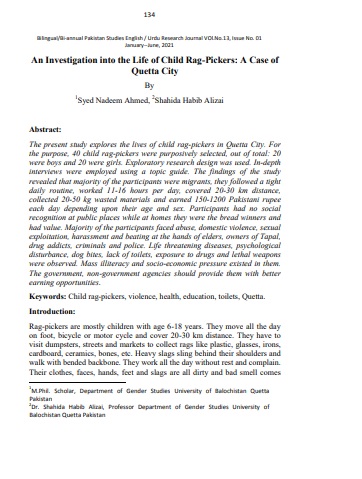An Investigation into the Life of Child Rag-Pickers A Case of Quetta City
Keywords:
Child rag-pickers, violence, health, education, toilets, Quetta.Abstract
The present study explores the lives of child rag-pickers in Quetta City. For
the purpose, 40 child rag-pickers were purposively selected, out of total: 20
were boys and 20 were girls. Exploratory research design was used. In-depth
interviews were employed using a topic guide. The findings of the study
revealed that majority of the participants were migrants, they followed a tight
daily routine, worked 11-16 hours per day, covered 20-30 km distance,
collected 20-50 kg wasted materials and earned 150-1200 Pakistani rupee
each day depending upon their age and sex. Participants had no social
recognition at public places while at homes they were the bread winners and
had value. Majority of the participants faced abuse, domestic violence, sexual
exploitation, harassment and beating at the hands of elders, owners of Tapal,
drug addicts, criminals and police. Life threatening diseases, psychological
disturbance, dog bites, lack of toilets, exposure to drugs and lethal weapons
were observed. Mass illiteracy and socio-economic pressure existed in them.
The government, non-government agencies should provide them with better
earning opportunities.
References
Aamir Abbas, D. S. (2018). A Socioeconomic Characteristics and Health
Problems of Trash Picking Children in Karachi. American Scientific
Research Journal for Engineering, Technology, and Sciences
(ASRJETS), 143-158.
Ahmed, A. (2017). Poverty, Education and Child Labour in Aligarh CityIndia. Journal of Social Sciences, 162-172.
Anjum, Z. B. (2016). A Sociological Study of Trash Picker Children in
Faisalabad City, Punjab,. Pakistan Journal of Life and Social
Sciences, 33-37.
Bal Kumar KC, Y. B. (2001). Investigating the Worst Forms of Child Labour,
Nepal, Situation of Child Ragpickers:. Geneva: International Labour
Organization, International Programme on the Elimination of Child
Labour (IPEC).
Chary, L. B. (2006). AN EMPIRICAL STUDY ON CHILD RAGPICKERS
IN WARANGAL CIT. Indian Journal of Human Rights and Justice,
Vol. 2,, 39-48.
Gelling, L. (2013). A feminist approach to research. Nurse Researcher , 6-7.
Giri, S. (2011). Status of Rag Pickers A Study of Narayanghat Bazaar,
Bharatpur, Chitwan, Nepal. In S. Giri, Status of Rag Pickers A Study
of Narayanghat Bazaar, Bharatpur, Chitwan, Nepal (pp. 1-48).
Bharatpur, Chitwan: Maiya Devi Girls College Bharatpur, Chitwan.
Hai, M. A. (2014). Problems Faced by the Street Children: A Study on Some
Selected Places in Dhaka City, Bangladesh. International Journal of
Scientific & Technology Research, 45-56.
Lal, S. (2019). Child Ragpickers in India: An Investigation into Waste
Managment Health Hazards and Earnings in Telangana. Economic
Challenger, 107-116.
Marcelo Cozzensa da Silva, C. E. (2005). World at Work: Brazilian
ragpickers. ResearchGate, 736-740.
Parveen, S. (2015). Child Ragpickers in Aligarh City. International Journal of
Scientific Research, 200-201.
S.Charles. (2018). A Study among the Problems Faced by Women Rag
Pickers in Madurai Corporation. World Wide Journal of
Multidisciplinary Research and Development, 42-43.
Silva, M. C. (2005). World at work: Brazilian ragpickers . Occupational
and Environmental Medicine, 736-740.
Vijaya, B. S. (2013). Problems of Child Ragpickers. International
Research Journal of Social Sciences, 6-11. Retrieved from



